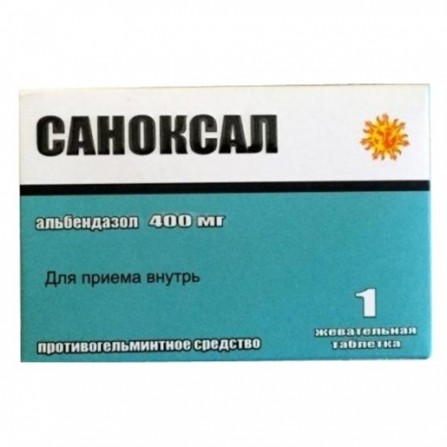Sanoxal chewable pills 400mg N1
Condition: New product
1000 Items
Rating:
Be the first to write a review!

More info
Active ingredients
Albendazole
Release form
Pills
Composition
1 tab. Albendazole 400 mg. Excipients: sucrose - 382 mg, lactose - 200 mg, sodium benzoate - 1 mg, sunset yellow sunset dye (sunset yellow dye) - 0.
Pharmacological effect
Antihelminthic and antiprotozoal agent. Selectively inhibits the polymerization of beta-tubulin, which leads to the destruction of cytoplasmic microtubules of intestinal cells of the worms; changes the course of biochemical processes (suppresses glucose utilization), blocks the movement of secretory granules and other organelles in the muscle cells of roundworms, causing their death. Most effective against larval forms of cestodes - Echinococcus granulosus and Taenia solium; nematode - Strongyloides stercolatis.
Pharmacokinetics
Absorption: After ingestion is poorly absorbed from the digestive tract due to poor solubility in water. The drug is rapidly metabolized during the "first pass" through the liver, therefore, plasma concentrations of albendazole in unchanged form are negligible and are not detected. Oral bioavailability is low. However, the simultaneous intake of fatty foods significantly increases the absorption and concentration of albendazole in the blood plasma (5 times). Cmax of albendazole sulfoxide is achieved in 2-5 hours. Distribution: Plasma protein binding is 70%. Albendazole is well distributed in the body, reaching high concentrations in urine and bile, liver, wall and fluid of parasitic cysts, cerebrospinal fluid. Metabolism: Albendazole is rapidly metabolized in the liver to form the primary metabolite, albendazole sulfoxide, which also has anthelmintic activity. Albendazole sulfoxide in turn is converted to albendazole sulfone (secondary metabolite) and other oxidized products lacking pharmacological activity. Albendazole is an inducer of CYP1A2 microsomal enzymes in human liver cells. Excretion: T1 / 2 albendazole sulfoxide is 8-12 hours. The drug is excreted in the form of various metabolites in urine and bile, while renal excretion is negligible (less than 1%). Pharmacokinetics in special clinical cases Against the background of liver damage, the bioavailability of albendazole increases. Cmax of albendazole sulfoxide increases by 2 times, and T1 / 2 is extended.In patients with impaired renal function, the clearance of albendazole and its metabolites does not change
Indications
- neurocysterosis, caused by larvae, : giardiasis, microsporidiosis - mixed helminthiasis - as an aid in the surgical treatment of echinococcosis cysts.
Contraindications
- children's age up to 3 years - hypersensitivity to the components of the drug - hypersensitivity to other benzimidazole derivatives. With care: oppression of bone marrow hematopoiesis, liver failure, liver cirrhosis, cysticercosis with the involvement of the retina.
Use during pregnancy and lactation
Not recommended for use in pregnancy, unless an alternative treatment is not possible. Before starting treatment in women of childbearing age, they are tested for the absence of pregnancy. During and during the month after the end of treatment, reliable contraception is mandatory. With extreme caution, the drug is prescribed during breastfeeding.
Dosage and administration
The drug is taken orally. Dose set individually, depending on the type of worms and body weight of the patient. With neurocysticercosis and echinococcosis, patients with a body weight of 60 kg and more are prescribed 400 mg 2 times / day, with a body weight less than 60 kg - in a dose of 15 mg / kg / day in 2 doses. The maximum daily dose is 800 mg. The course of treatment for neurocysticercosis - 8-30 days, with echinococcosis - 3 cycles of 28 days with a 14 day break between cycles. In surgical treatment, the duration of drug treatment is 3 courses. In case of ascariasis, trichocephalosis, enterobiasis, ankilostomidosis, adults and children over 3 years old - 400 mg once a day, if necessary, repeat after 3 weeks. With giardiasis in adults and children over 3 years old - 400 mg 1 time / day for 3 days. With strongiloidosis and cestodosis in adults and children over 3 years old - 400 mg 1 time / day for 3 days, if necessary, repeat after 3 weeks. Tablets can be chewed or swallowed whole.
Side effects
On the part of the digestive system: abnormal liver function with a change in functional liver tests (mild or moderate increase in transaminase activity), abdominal pain, nausea, vomiting. On the part of the hematopoietic system: inhibition of bone marrow hematopoiesis (leukopenia, granulocytopenia, agranulocytosis, thrombocytopenia, pancytopenia). Nervous system disorders: headache, dizziness, meningeal symptoms. Allergic reactions: skin rash, itching. Other: fever, increased blood pressure, acute renal failure, reversible alopecia.
Overdose
Treatment: gastric lavage, taking activated charcoal, conducting symptomatic therapy.
Interaction with other drugs
When combined, dexamethasone, cimetidine, praziquantel increase the concentration of albendazole sulfoxide in the blood.
special instructions
Patients with neurocysticercosis should receive appropriate therapy of corticosteroids and anticonvulsants. GCS for oral and intravenous administration are used to prevent a sharp increase in blood pressure in the first week of anti-cystic therapy. It is recommended to control the blood cell composition; blood tests should be performed at the beginning of each 28-day cycle and every 2 weeks during the period of albendazole therapy. In the event of leukopenia treatment is suspended. Continuation of treatment with albendazole is possible if the decrease in the total content of leukocytes and neutrophil leukocytes is moderate and does not progress. For abnormal liver function, before and during treatment, regular laboratory monitoring is necessary (every 2 weeks). In the case of a significant increase in liver transaminases, treatment should be discontinued. However, if the level of liver enzymes returned to the original, then albendazole can be re-appointed, subject to continuous monitoring of laboratory parameters. In case of neurocysticercosis with eye lesion, before starting treatment, it is necessary to study the retina due to the risk of aggravating its pathology. Use in pediatrics. Caution should be prescribed the drug to children aged 3 to 6 years.





